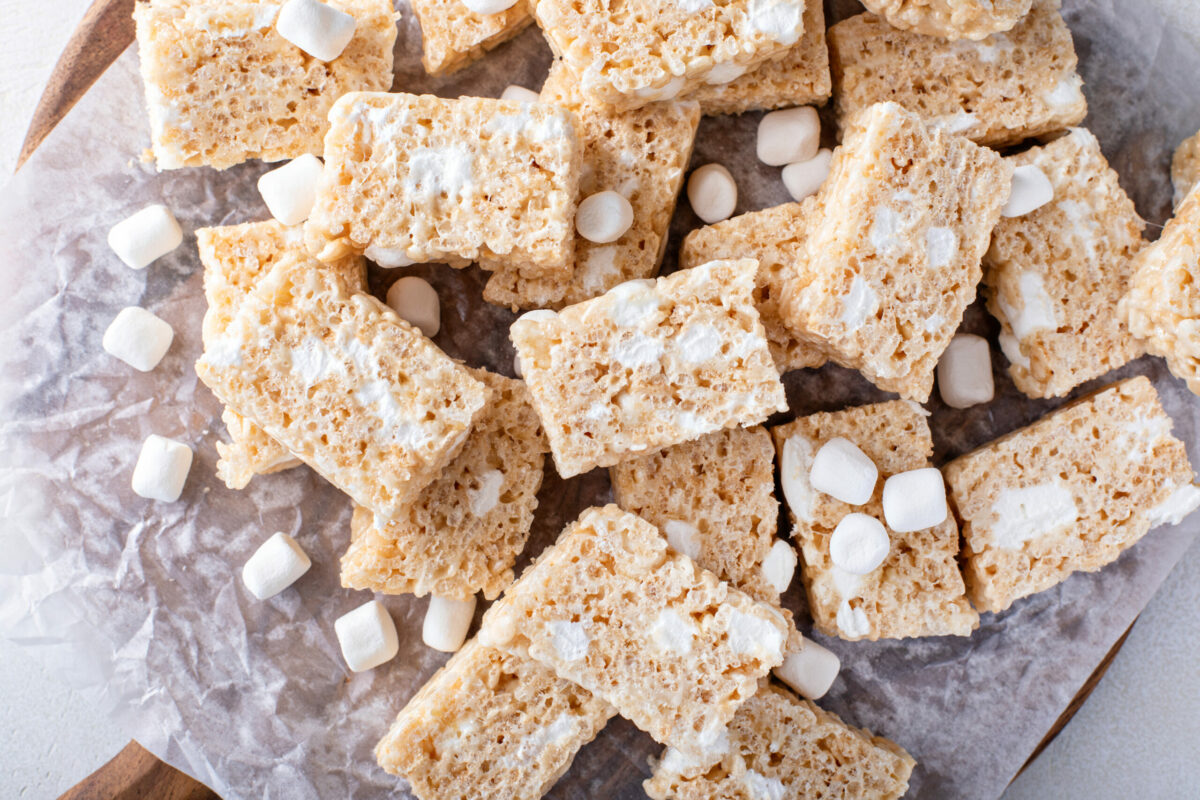Irresistible Gluten-Free Rice Krispies – Snap, Crackle, and Pop without Gluten Worries!
The topic of gluten-free diets has gained significant attention in recent years, with more individuals seeking alternatives to gluten-containing foods due to gluten sensitivity or celiac disease. Read more of the topic Gluten-Free Rice Krispies 101: Everything You Need to Know.
One popular item that has garnered curiosity among those following a gluten-free lifestyle is “Rice Krispies.” These crispy, puffed rice cereal treats have been a beloved part of breakfast and snack time for generations. However, concerns about gluten content have led many to wonder, “Are Rice Krispies gluten-free?”

Rice crispy marshmallow treats with white chocolate and raspberries
In this comprehensive exploration, we delve into the truth behind Rice Krispies and gluten, debunking myths and uncovering the facts. We will examine the composition of Rice Krispies, potential gluten contamination in food processing, and the availability of gluten-free varieties.
Additionally, we will explore explore gluten-free alternatives and provide insights on label reading, certifications, and consumer experiences. By the end, readers will gain a comprehensive understanding of navigating gluten-free choices for a safe and enjoyable diet.
Understanding Gluten and Celiac Disease
Gluten is a protein found in wheat, barley, rye, and their derivatives. Celiac disease is an autoimmune disorder triggered by gluten consumption, causing damage to the small intestine lining.
Understanding the relationship between gluten and celiac disease is crucial as it highlights the importance of finding gluten-free alternatives for those with gluten intolerance or celiac disease.
By exploring this connection, individuals can make informed choices about their diet and ensure they avoid gluten-containing foods like traditional Rice Krispies.
The Composition of Rice Krispies: Gluten-Free Ingredients
Delving into the composition of Rice Krispies reveals that they are made primarily from rice, which is naturally gluten-free.
The absence of wheat, barley, or rye in the ingredients makes the original Rice Krispies cereal suitable for those on a gluten-free diet. However, consumers should remain cautious of potential cross-contamination during production and processing, as this could introduce gluten into the product.
Manufacturers are increasingly adopting gluten-free practices to address this concern and provide safer options for individuals with gluten sensitivity.
Gluten Contamination in Food Processing
Cross-contamination can occur during food processing when gluten-free products come into contact with gluten-containing ingredients or equipment.
This subtopic explores the challenges that food manufacturers face in preventing gluten contamination during the production of gluten-free Rice Krispies.
It also discusses industry standards and practices designed to minimize the risk of cross-contamination and ensure the gluten-free integrity of the final product.
Rice Krispies Varieties: Gluten-Free Options

Traditional rice crispy treats cut up on the table, kids snack idea
While the original Rice Krispies are naturally gluten-free, this subtopic focuses on exploring the various gluten-free Rice Krispies options available in the market.
It introduces readers to alternative flavors and varieties that cater specifically to gluten-sensitive individuals.
From chocolate-infused Rice Krispies to those made from organic brown rice, the assortment of gluten-free choices allows consumers to enjoy a diverse range of flavors while maintaining dietary restrictions.
Reading Labels and Identifying Gluten in Rice Krispies
For individuals with gluten sensitivity, reading product labels is essential to ensure they are consuming safe foods. This subtopic delves into the nuances of label reading and educates readers on identifying gluten in Rice Krispies and other food products.
It includes tips on understanding gluten-related terminologies, deciphering allergy warnings, and spotting hidden sources of gluten in ingredient lists.
Cross-Contamination Concerns and Precautions
Building on the discussion of cross-contamination, this subtopic delves deeper into the precautions individuals can take to avoid gluten exposure.
It provides practical advice on managing a gluten-free kitchen, using separate utensils, and avoiding shared equipment that might pose a risk of gluten contamination. By adopting these precautions, individuals can better safeguard their health while enjoying gluten-free Rice Krispies.
Gluten-Free Certifications and Third-Party Testing
To instill confidence in consumers, many gluten-free products, including Rice Krispies, undergo third-party testing and earn gluten-free certifications.
This section examines various gluten-free certifications and explains how they help verify the gluten-free status of products. By seeking products with reliable certifications, individuals can be confident in their gluten-free choices and trust that they are free from potential cross-contamination.
Consumer Experiences: Reviews and Feedback
Real-world experiences and feedback from consumers can be valuable in understanding the gluten-free landscape for Rice Krispies.
This section presents consumer reviews and feedback from individuals who have tried different gluten-free Rice Krispies products.
By learning from others’ experiences, readers gain insights into the taste, texture, and overall satisfaction of various gluten-free Rice Krispies options.
Gluten-Free Alternatives to Rice Krispies
Sometimes, individuals with gluten sensitivity may prefer to explore other gluten-free alternatives to Rice Krispies. This section introduces readers to a variety of gluten-free cereal and snack options that can serve as satisfying replacements for traditional Rice Krispies.
It highlights the diversity of choices available, catering to different taste preferences and dietary requirements.
In the final subtopic, the focus shifts to summarizing the key takeaways from the exploration of gluten-free Rice Krispies.
It emphasizes the importance of understanding gluten, recognizing safe gluten-free options, and being proactive in managing cross-contamination risks.
By adopting a cautious approach and staying informed, individuals can confidently enjoy gluten-free Rice Krispies and make safer dietary choices that align with their gluten sensitivity or celiac disease management.
Gluten-Free Rice Krispy Recipes and Homemade Alternatives
In this subtopic, we explore creative and delicious gluten-free Rice Krispy recipes and homemade alternatives. We’ll cover various options for making gluten-free treats using alternative ingredients while retaining the delightful crunch and flavor. Some recipe ideas may include:
1. Homemade Gluten-Free Rice Krispy Treats: A classic recipe using gluten-free Rice Krispies, marshmallows, and butter or dairy-free alternatives.
2. Nut Butter Rice Krispy Bars: Adding nut butters like almond, peanut, or cashew to the mix for extra flavor and protein.
3. Chocolate Rice Krispy Treats: Incorporating gluten-free chocolate and cocoa to create a delightful twist on the classic treat.
4. Fruity Rice Krispy Bars: Introducing dried fruits like cranberries, raisins, or apricots for a burst of natural sweetness.
5. Coconut Rice Krispy Squares: Using shredded coconut to add texture and tropical flavor to the traditional recipe.
6. Vegan Rice Krispy Treats: Adapt the recipe with vegan marshmallows and plant-based butter for a cruelty-free alternative.
7. Rice Krispy Energy Bites: Transforming the cereal into bite-sized energy snacks with nuts, seeds, and honey or agave syrup.
8. Rice Krispy Ice Cream Sandwiches: Sandwiching gluten-free ice cream between two layers of Rice Krispy bars for a delightful frozen treat.
These creative recipes will cater to gluten-free individuals looking to enjoy the beloved Rice Krispy experience while accommodating their dietary needs and preferences.
Few gluten-free Rice Krispy brands:
1. Original Kellogg’s Gluten-Free Rice Krispies: Kellogg’s offers a gluten-free version of their classic Rice Krispies cereal made with whole-grain brown rice.
2. Barbara’s Gluten-Free Rice Crisp Cereal: Barbara’s produces a gluten-free alternative to traditional Rice Krispies, using organic brown rice.
3. Nature’s Path Gluten-Free Crispy Rice Cereal: Nature’s Path offers a gluten-free option made with organic whole-grain brown rice.
4. One Degree Organic Foods Sprouted Brown Rice Crisps: One Degree Organic Foods provides a gluten-free, sprouted brown rice version of crisped rice cereal.
5. Erewhon Gluten-Free Crispy Brown Rice Cereal: Erewhon’s gluten-free option is made with organic brown rice, offering a wholesome alternative.
Remember to always double-check the product labels and manufacturing processes to ensure they are free from gluten and cross-contamination.
Conclusion – Gluten-Free Rice Krispies
In conclusion, Rice Krispies are gluten-free by nature, made primarily from rice. However, cross-contamination during processing can be a concern. Fortunately, gluten-free alternatives are available, ensuring safe consumption for those with gluten sensitivity or celiac disease.
By reading labels and seeking certified products, individuals can confidently enjoy Rice Krispies while accommodating their dietary needs.
Whether savoring the classic version or exploring creative homemade alternatives, Rice Krispies remain a beloved treat that brings joy to breakfast and snack time for all. So, this concludes the topic of Gluten-Free Rice Krispies 101: Everything You Need to Know.
FAQs About Gluten-Free Rice Krispies
Is Walmart brand Rice Krispies gluten-free?
No, Walmart brand Rice Krispies are not gluten-free. They typically contain wheat-based ingredients, making them unsuitable for those with gluten sensitivity or celiac disease.
Is Trader Joe’s crispy rice cereal gluten-free?
Yes, Trader Joe’s crispy rice cereal is gluten-free. It is made from rice and does not contain any gluten-containing ingredients, making it a safe choice for individuals to avoid gluten.
Are Rice Krispies cereals vegan?
Regular Rice Krispies cereals are not vegan as they contain marshmallows made from gelatin, which is derived from animal sources. However, some brands offer vegan alternatives using plant-based marshmallows, making them suitable for vegans.
Are Rice Krispies Halal?
The Halal status of Rice Krispies can vary depending on the specific brand and its production process. Some brands may use Halal-certified ingredients, but it is essential to check individual product labels or contact the manufacturer for confirmation.
Are there gluten-free versions of Rice Krispies?
Yes, there are gluten-free versions of Rice Krispies available from various brands. These alternatives use gluten-free grains, such as brown rice, and are produced in gluten-free facilities to minimize cross-contamination risks.
Can I make gluten-free Rice Krispy treats at home?
Yes, you can make gluten-free Rice Krispy treats at home using gluten-free Rice Krispies or other gluten-free crispy rice cereals. Simply substitute regular Rice Krispies with a gluten-free alternative and follow your favorite recipe for homemade gluten-free treats.
Are Rice Krispies safe for children with celiac disease?
Regular Rice Krispies are not safe for children with celiac disease due to gluten content. However, gluten-free Rice Krispies options are available, ensuring a safe and enjoyable treat for children with celiac disease.
What should I look for on the label to identify gluten-free Rice Krispies?
Look for labels indicating “gluten-free” or “certified gluten-free” on the packaging. Additionally, check the ingredient list to ensure there are no wheat, barley, or rye-based ingredients, as they contain gluten.
Can I find organic gluten-free Rice Krispies?
Yes, there are organic gluten-free Rice Krispies options available from some brands. These products are made from organic rice and are free from gluten-containing grains.
Are there any Rice Krispies cereal varieties suitable for a kosher diet?
Yes, there are kosher-certified Rice Krispies cereal varieties available. Look for products with the appropriate kosher certification symbol on the packaging to ensure they meet kosher dietary guidelines.
As an experienced WordPress blogger, I possess extensive expertise in constructing captivating blog websites. My proficiency extends to various areas, including content writing, meticulous niche and keyword research, and the implementation of on-page SEO techniques to maximize visibility and engagement.



